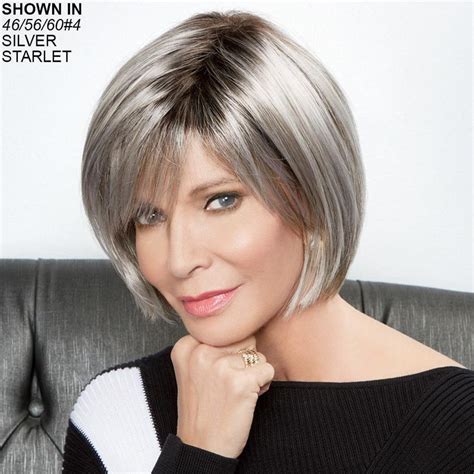The long, flowing white wig has been a timeless accessory, gracing the heads of royalty, performers, and fashion-forward individuals for centuries. Its ethereal appearance and versatility have made it a staple in a wide range of settings, from historical reenactments to modern-day runway shows.

A Historical Journey: The Long White Wig through the Ages
Wigs have been worn for thousands of years, with archaeological evidence suggesting their use as early as 3000 BC in ancient Egypt. However, it was during the 17th century that the long white wig became a symbol of power and prestige.
King Louis XIV of France popularized the periwig, an elaborate wig made of horsehair or silk. His courtiers and nobles eagerly adopted this fashion, and the wig quickly became a status symbol throughout Europe. The white color was chosen to convey wealth and power, as it was believed to create the illusion of youth and vitality.
The Long White Wig in Modern Fashion
Although the periwig fell out of fashion in the 18th century, the long white wig has continued to be a popular choice for performers and fashion enthusiasts. In the theater, it is often used to create historical characters or to evoke a sense of grandeur. On the runway, designers have embraced the wig as a statement piece, adding an element of fantasy and sophistication to their collections.
The Wig Revolution: A New Era of Innovation
Traditional long white wigs were typically made of synthetic fibers, which could be stiff, uncomfortable, and unnatural looking. However, recent advancements in wig-making technology have led to the creation of more realistic and comfortable wigs that offer a wide range of options for customization.
One of the most innovative materials is the monofilament wig, which uses a thin, transparent mesh to create a natural-looking scalp effect. This allows the wig to be styled and parted in a variety of ways, giving the wearer greater versatility.
Beyond Historical and Fashion Applications: The Long White Wig Reimagined
The long white wig is no longer confined to traditional or fashion-related applications. Its unique aesthetic and versatility have inspired its use in various creative and practical settings.
1. Characterization and Storytelling
Long white wigs have been used to create a wide range of characters in films, television shows, and theater productions. From the iconic white-haired wizard Gandalf in “The Lord of the Rings” to the eccentric Professor Snape in “Harry Potter,” the wig has the power to transform an actor into a believable and captivating character.
2. Educational Purposes
In educational settings, long white wigs can be used as a teaching tool to simulate historical figures or to facilitate role-playing exercises. By wearing a wig, students can step into the shoes of a different character and gain a deeper understanding of their motivations and perspectives.
3. Medical and Cosmetic Applications
Long white wigs have also found practical applications in the medical and cosmetic industries. They can be used to cover hair loss caused by chemotherapy or other medical conditions, providing comfort and confidence to patients. Additionally, wigs can be used as a form of cosmetic enhancement, adding volume, length, and color to natural hair.
The Long White Wig: A Versatile and Enduring Accessory
The long white wig continues to be a timeless and versatile accessory with an enduring appeal. Its historical significance, modern fashion applications, and innovative materials have ensured its relevance in a wide range of settings.
From historical reenactments to runway shows and beyond, the long white wig has the power to transform, educate, and inspire. As we continue to explore its possibilities, it is clear that this accessory will continue to play a vital role in the realm of creativity and self-expression.
Key Points:
- Long white wigs have been worn for centuries, symbolizing power and prestige.
- Modern wig-making technology has led to more realistic and comfortable options.
- The wig is used in various applications, including characterization, education, and medicine.
- Its versatility and timeless appeal ensure its continued relevance in the realm of creativity and self-expression.
Tables:
| Historical Period | Notable Figures Who Wore Long White Wigs |
|---|---|
| 17th Century | King Louis XIV, Isaac Newton |
| 18th Century | George Washington, Marie Antoinette |
| 19th Century | Abraham Lincoln, Queen Victoria |
| 20th Century | Winston Churchill, Albert Einstein |
| Modern Applications of Long White Wigs | Industries |
|---|---|
| Characterization | Film, television, theater |
| Education | Historical reenactments, role-playing |
| Medicine and Cosmetics | Covering hair loss, adding volume |
| Fashion | Runway shows, editorial shoots |
| Types of Long White Wigs | Materials |
|---|---|
| Traditional | Synthetic fibers |
| Monofilament | Thin, transparent mesh |
| Lace Front | Hand-tied lace |
| 360 Lace | Lace surrounding the entire wig |
| Choosing the Right Long White Wig | Factors to Consider |
|---|---|
| Material | Synthetic, human hair, monofilament |
| Length | Short, medium, long |
| Style | Curly, straight, wavy |
| Cap Size | Small, medium, large |
| Price | Affordable, mid-range, luxury |
